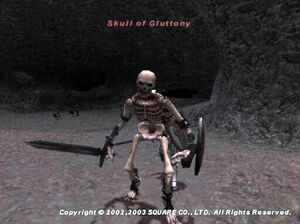Skull of Gluttony: Difference between revisions
(Created page with "{| border="0" width="100%" |width="50%" align="left" valign="center"| '''Job:''' <br> '''Family:''' Skeleton<br> '''Crystal:''' {{Earth|Earth}}<br> '''Weak to:''' {{Fire|Fire}}, {{Light|Light}} {{Color|NM|Notorious Monster}} |width="50%" align="center"| thumb|Skull of Gluttony |} {| border="0" width="100%" cellpadding="4" cellspacing="2" class="ffxi-table wide-table" |- !Zone !Level !Drops !Spawns !Notes |- |align=...") |
mNo edit summary |
||
| Line 1: | Line 1: | ||
{| | {{Infobox Monster | ||
| | | image = Skull of Gluttony.jpg | ||
| image caption = Skull of Gluttony | |||
| job = | |||
| family = Skeletons | |||
| crystal = Earth | |||
| weaknesses = {{element|Fire}} {{element|Light}} {{Blunt}} | |||
{{ | | resistances = | ||
| immunities = | |||
| | | absorbs = | ||
| type = Notorious Monster | |||
|} | | subtype = | ||
{| | | tier = | ||
| title obtained = | |||
!Zone | }} | ||
{| class="nms horizon-table table-xl" | |||
! Zone || Level || Drops || Steal || Spawns || Notes | |||
|- | |- | ||
| | |||
[[Eldieme Necropolis]] | [[Eldieme Necropolis]] | ||
|align="center"| | |align="center"| | ||
60 | 60 | ||
| | |||
*[[Chrysoberyl]] | *[[Chrysoberyl]] {{Hxi Drop Rate|100%}} | ||
*[[Gluttony Sword]] | *[[Gluttony Sword]] {{Hxi Drop Rate|asb=100/1000|0|0}} | ||
| | |||
|align="center"| | |align="center"| | ||
1 | 1 | ||
| Line 31: | Line 30: | ||
A, H, HP | A, H, HP | ||
|- | |- | ||
!colspan="6"| | |||
{{Monster Notes}} | {{Monster Notes}} | ||
|} | |} | ||
| Line 52: | Line 51: | ||
The Seven Holy Virtues, sometimes called the Contrary Virtues, oppose the Seven Deadly Sins. The Holy Virtue that opposes the Sin of Gluttony is Abstinence (Frenum). This virtue gives self-control and moderation, which inhibits the unrestrained appetites of the body's desires that define Gluttony. The Seven Holy Virtues are different from the Seven Heavenly Virtues (See: the Jailers of Sea). | The Seven Holy Virtues, sometimes called the Contrary Virtues, oppose the Seven Deadly Sins. The Holy Virtue that opposes the Sin of Gluttony is Abstinence (Frenum). This virtue gives self-control and moderation, which inhibits the unrestrained appetites of the body's desires that define Gluttony. The Seven Holy Virtues are different from the Seven Heavenly Virtues (See: the Jailers of Sea). | ||
Latest revision as of 20:39, 21 January 2024
| Zone | Level | Drops | Steal | Spawns | Notes |
|---|---|---|---|---|---|
|
60 |
1 |
A, H, HP | |||
|
HP = Detects Low HP; M = Detects Magic; Sc = Follows by Scent; T(S) = True-sight; T(H) = True-hearing JA = Detects job abilities; WS = Detects weaponskills; Z(D) = Asleep in Daytime; Z(N) = Asleep at Nighttime; A(R) = Aggressive to Reive participants | |||||
Notes:
- Spawns by the Tallow Candle at J-6 when all 7 candles are alight.
- Tallow Candles are found throughout the Necropolis and can be lit by trading a Flint Stone. They remain lit for 5 minutes; the Flint Stones are not lost.
- Each of the Skull NMs can be spawned every hour (Earth time).
- Title obtained: Skullcrusher.
Historical Background
The Seven Deadly Sins
The Seven Deadly Sins were 7 sins which were considered cardinal, a category within mortal sins (as opposed to the venial sins). They were unforgivable spiritual transgressions which would merit damnation because they corrupted one's soul, cutting off the sinner from the grace of God. The concept originated with 8 evil thoughts (logismoi) by Evagrius of Pontus, a 4th century CE monk. They were: Pride, Vainglory, Anger, Avarice, Gluttony, Fornication (Lust), Acedia, Sadness (also called Despondency, Dejection; Latin "Tristitia"). Pope Gregory I in the 6th century CE defined a list of sins: Pride, Vainglory, Envy, Wrath, Avarice, Gluttony, Lust, Sadness/Acedia. It took a while for this list to be accepted and narrowed down to seven (Gregory defined 8 sins, though through a perceptual flaw consolidating history, the common, but erroneous view is that he enumerated 7. He stated there were 7 principal sins, 5 spiritual sins and 2 carnal sins, and all these sins stem from pride. Pride and Vainglory were not merged until later). It was not until the 10th century that the list settled on seven. The Seven Deadly Sins in order of severity from least worst to most worst: Pride, Envy, Wrath, Sloth, Greed, Gluttony, Lust. All seven sins can be considered as deriving from desire: Pride (desire to be the best), Envy (desire to have the qualities of others and for others to not have that quality), Wrath (desire for others to be harmed or suffer), Sloth (desire to do nothing or not have conviction of faith), Greed (desire for material goods), Gluttony (desire for consumables), Lust (desire for sex). The Seven Deadly Sins are primarily limited to the Roman Catholic denomination of Christianity.
The Sin of Gluttony
Gluttony (Gula) is overindulgence in anything the body can partake of, food, drink, drugs. Anything beyond that which one needs is classified as Gluttony. Hoarding anything from others, be it food or material objects, was considered a form of Gluttony (different from Avarice, which is the desire for that thing. Gluttony is desire to hold onto that thing for one's exclusive use). It includes eating too much, drunkenness, and "soft living". Gluttony was a sin because it violates the principle of moderation, abandoning oneself to desire. Gluttony is considered the 6th sin in terms of severity. In the Medieval era, an animal, a color, and a punishment were associated with each sin. Gluttony was associated with the color orange and the pig. The punishment for the Sin of Gluttony was to be forced to eat rats, snakes, and toads in Hell.
The Seven Holy Virtues, sometimes called the Contrary Virtues, oppose the Seven Deadly Sins. The Holy Virtue that opposes the Sin of Gluttony is Abstinence (Frenum). This virtue gives self-control and moderation, which inhibits the unrestrained appetites of the body's desires that define Gluttony. The Seven Holy Virtues are different from the Seven Heavenly Virtues (See: the Jailers of Sea).


